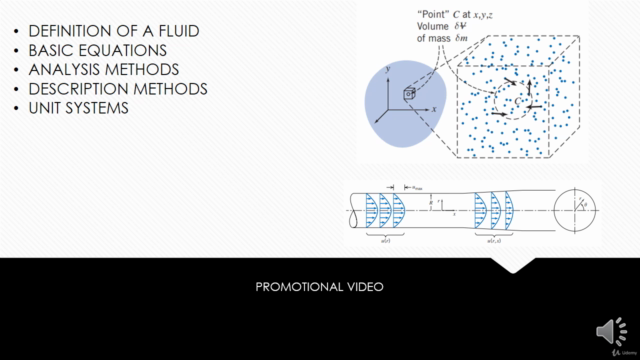Fluid Mechanics
Kinematics, statics and dynamics of fluids

What you will learn
Analysis of the basic concepts that allow differentiating fluids from solids.
Establishment of differential relationships for a fluid particle.
Application of the principle of conservation of mass.
Application of the principles of momentum in fluid dynamics.
Why take this course?
Apply the basic principles of the behavior of Newtonian fluids, after describing them, to solve specific problems.
Analysis of the basic concepts that allow differentiating fluids from solids.
Establishment of differential relationships for a fluid particle.
Application of the principles of mass and moment conservation in fluid dynamics.
Know the statics, kinematics and dynamics of fluids
As the name implies, fluid mechanics is the study of fluids at rest or in motion. It has traditionally been applied in such areas as the design of canal, levee, and dam systems; the design of pumps, compressors, and piping and ducting used in the water and air conditioning systems of homes and businesses, as well as the piping systems needed in chemical plants; the aerodynamics of automobiles and sub- and supersonic airplanes; and the development of many different flow measurement devices such as gas pump meters.
While these are still extremely important areas (witness, for example, the current emphasis on automobile streamlining and the levee failures in New Orleans in 2005), fluid mechanics is truly a “high-tech” or “hot” discipline, and many exciting areas have developed in the last quarter-century. Some examples include environmental and energy issues (e.g., containing oil slicks, large-scale wind turbines, energy generation from ocean waves, the aerodynamics of large buildings, and the fluid mechanics of the atmosphere and ocean and of phenomena such as tornadoes, hurricanes, and tsunamis); biomechanics (e.g., artificial hearts and valves and other organs such as the liver; understanding of the fluid mechanics of blood, synovial fluid in the joints, the respiratory system, the circulatory system, and the urinary system); sport (design of bicycles and bicycle helmets, skis, and sprinting and swimming clothing, and the aerodynamics of the golf, tennis, and soccer ball); “smart fluids” (e.g., in automobile suspension systems to optimize motion under all terrain conditions, military uniforms containing a fluid layer that is “thin” until combat, when it can be “stiffened” to give the soldier strength and protection, and fluid lenses with humanlike properties for use in cameras and cell phones); and microfluids (e.g., for extremely precise administration of medications).
Screenshots



